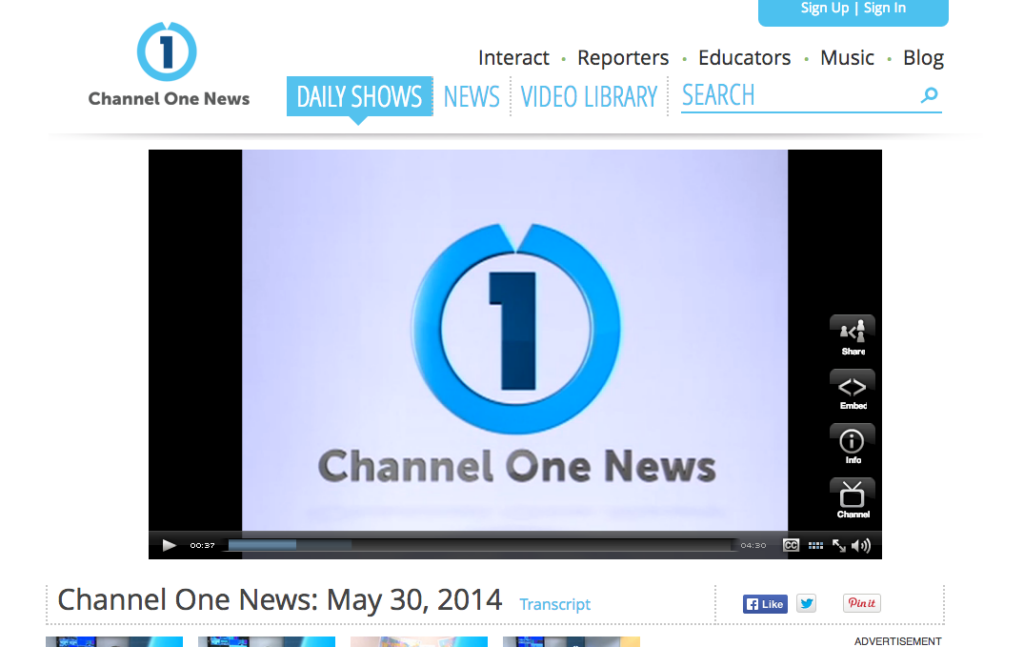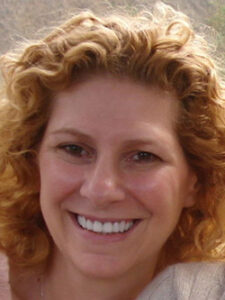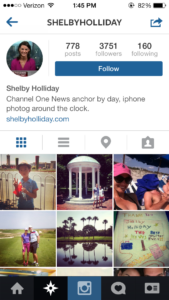When I was a kid in school, I watched the Channel One News program on old, wall-mounted TVs that turned on automatically during homeroom. But over the years, Channel One News has had to recognize that kids and teachers alike are using a variety of devices and platforms to consume information, including videos.
Channel One News started 23 years ago as a 10-minute daily news program produced specifically for kids. Its core product has remained the same, but the company has changed significantly.

Channel One News revamped its website in June 2013 to make its content easier for kids, teachers and parents to access based on how they interact with media. More attention was given to how to allow users to share and interact with the already bite-sized segments it produces for its daily product. This set-up frees up its content from those wall-mounted TVs, allowing it to be used in the variety of blended learning, flipped classroom and bring-your-own-device teaching environments that increasingly exist in public schools.
More than technology has forced adaptation as well. As states have begun to adapt to new standards, including the Common Core, many news-centric educational products have seen an opportunity. In January 2014, Channel One News launched the “Channel One News Curriculum.” Today’s Channel One News is a subscription-based school product offering standards-aligned instructional routines tied to a segment from each day’s show.
As of early May, Channel One News has a new parent: Houghton Mifflin Harcourt, the educational and trade publisher widely-known for its textbook publishing. The acquisition won’t affect the “day-to-day operations” of Channel One News, according to a spokesperson, but it will “help HMH to further integrate informative, engaging and standards-aligned nonfiction video content into its core product offerings and beyond,” according to a press release.
I caught up with Channel One News CEO CJ Kettler — I didn’t ask about Anderson Cooper, an alumni anchor of the program — but we did chat about the role of anchor age in relating with its audience, how to make video work for kids in an age of many screens, and other changes Channel One News has made in order to transform.
You cover news from a “kid/teen perspective.” For example, when your anchor Shelby Holliday went to the Philippines to cover last year’s typhoon, you told me she interviewed the young people in the area to see how they were affected. When she went to South Africa to cover the death of Nelson Mandela, she spoke to kids about Mandela’s lasting impact. Why take this approach?

CJ Kettler
Our mission is to encourage kids to be informed, digital-savvy global citizens. We think our best opportunity to engage them is to present the news in a way that’s relatable, accessible and most interesting to them. To a 15-year-old in the U.S., hearing about the impact of the life and death of Nelson Mandela on the evening news might feel too remote to be relevant. But when Shelby — an anchor they know and have built a relationship with– travels to South Africa, and interviews a 15-year-old about how he’s been impacted by Nelson Mandela, it completely changes the experience – and impact — for our audience.
We also recognize that if a student were to turn on the evening news, he/she may not have the context needed to really understand the complexity of any given world event or news story. As a rule, we provide “explainers” that include historical context and graphics that more fully describe the complexity of a topic or situation. In addition, by highlighting our interviews with young people on the scene of an event, we provide context from a young person’s perspective, which helps support a deeper understanding of a world event or topic.
Many youth and media programs — like Newspapers in Education, for instance — focus on getting youth to interact and understand news through newspapers and their websites or other text formats. Are there advantages to doing a broadcast-style news show when it comes to reaching youth?
We think so. One of our strongest differentiators [from other youth and media projects] is our young team of digital journalists and anchors. Our on-air talent report the news from a young person’s perspective, and from the feedback we’ve received we know this makes the information much more relatable and accessible overall. In addition, kids learn in a variety of modalities, so integrating graphics, audio, and the visual cues of a broadcast news show enables all kinds of learners to participate.
From an educational perspective, there’s been an enormous uptick in teachers looking to integrate nonfiction, standards-aligned video and informational text into their daily lesson plans. With our video, transcript, and related supplementary resources that accompany each show, we provide a significant amount of nonfiction content on a daily basis.
Also, we are not only broadcast in the schools. We distribute across platforms, so our programming is available on our website, and we have seen a significant increase in usage across mobile devices.
We’ve seen a number of organizations trying to change how they approach news video intended to be consumed across different devices. The general idea is that the way we use a mobile phone to consume news is different than the passive form of watching news on a television. These are differences we’ve been noticing for adults, but I imagine differences exist for youth, too. What have you found that works well in terms of designing video intended for different platform and aimed at youth?
As people of all ages look for bite-sized, informational videos, we feel like we’ve been ahead of that curve, having always produced short-form news. We have an extensive library of feature segments, so if a kid — or teacher — is interested in a particular news story they can browse our library on their computer, mobile device or tablet and find relevant videos that run about 2 – 5 minutes.
We also know how much our audience likes to interact with our content on social media, so we share many of our videos across social platforms and encourage our audience to do the same.
How are you approaching getting youth — in their free time — to follow or get involved with something they might see primarily as “something they do at school”?
We approach this in a few different ways. First, we work really hard to create a relevant, relatable daily news show that both informs and inspires our audience. So while they might not be in school watching our program in July, if a major news event happens, they might come to channelone.com to learn more about it.
We also make sure that we balance our news content with engaging interactive content on both our website and across our social platforms. For example, every Tuesday, we post a behind-the-scenes photo of one of the anchors and we ask our kids to caption the photo. Every Friday, we announce the winner on the show. Kids and teachers love it – it’s our most successful content campaign – and they are often submitting their captions outside of school hours.
We also work hard to spark discussions around the news events that we know will resonate with our audience. We ran a story earlier this Spring about Sheryl Sandberg’s “Ban Bossy” campaign, and we had kids commenting well into the night with their thoughts on the campaign.

A comment on a story on Sheryl Sandberg’s “Ban Bossy” campaign
Finally, our anchors all spend time building relationships with our audience on their own social platforms. Again, those dialogues are mostly happening outside of school time.
Channel One News does anchor names on the chyron different than many TV news shows. Some TV news programs are doing Twitter handles, yes, but instead of a Twitter handle, you show an anchor’s handle on Instagram. Why is that? Did you build some of your strategy off of some research and if so, what was it?

Note the chyron
For the last few years, we’ve had highly engaged Twitter and Facebook platforms. When we decided to expand our presence to other social platforms, we asked our audience where they spent the majority of their time and found that most of them were on Instagram. Not only do young people have a presence there, but they’re engaging on Instagram all day long. So we launched our Channel One News Instagram account in September of 2013, and it’s our fastest growing social platform.
Our anchors have the ability to choose which of their own social media platforms they’d like to have promoted on the show so kids know where they can follow them. They also chose Instagram.

Are there any other “little details” you’ve found that help tell or explain the news to youth and how it works?
This generation of students are interested and motivated to make a difference based on the news of the day. When we launched the new website last June, we also launched an Impact section, where we talk about different ways that kids can get involved and make a difference in their own communities.
We also want to have outlets for kids to weigh in and share their opinions on the stories we cover in the daily program. We offer a variety of ways for students to participate — from sending in their comments to us for a chance for it to be included in the next day’s show to engaging in conversations with them across all of our social media platforms including Instagram, Twitter and Facebook.
What do you lose if you don’t invite youth to participate?
So much! Their voice, their immense impact, their amazing ideas. We take every opportunity to encourage our audience to participate and share their interests, thoughts and questions with us.
You might also be interested in:
As research continues to inform this slice of the news industry, we’ll continue learning, too. Who gets to be called a journalist in 2025 and beyond? What is the future of trustworthy information, especially considering the access to and trust for online content creators? How might journalism adapt to the rise, or co-opt the styles, of news influencers?
What if we started looking at our output as a product, not a service? Too often, we think "product" means a fancy app or a new website. But product isn’t about tech. It’s about intention.
When we began asking what kind of stories still mattered to Baca County, we realized many of them weren’t “breaking news” but generational memory. And the paper was the last remaining platform that treated those memories with care and context.


